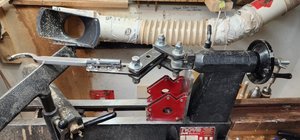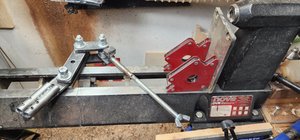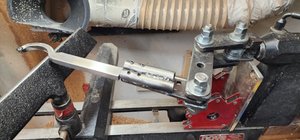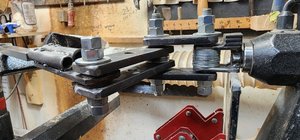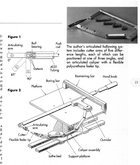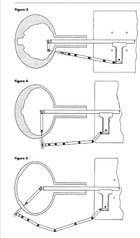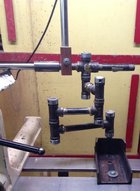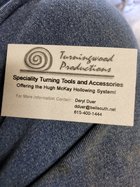My DIY hollowing stabilizer turned out MUCH better than I expected it to. It works really smoothly! My minimal welding skill along with my cheapo welder does not do "pretty" welds... but they are strong.
With the exception of the 5/8 bar for the hollowing tools, all the other metal came from my "Maybe I'll have a use for this someday" pile.... and I already had the carbide cutters so my total cost to make this was under $50 for 6 thrust bearings, the 5/8 bar, the nuts, washers and ready rod...
The stabilizer is attached to a 1/2 inch threaded rod that goes thru the tailstock and is secured with a wing nut. After the initial trial run I found that the torque of the lathe was turning the unit so I found a thick piece of steel that is held in place with 2 welding magnets. That stops it from turning. If any of you are planning to make this, I'm sure a piece of 3/4 inch plywood with a 1/8 inch metal bar top and bottom would do the same thing and would be much easier to get. Be sure to get THRUST bearings, not conventional ones. 6 cost $20 on Canadian Amazon. Less for those of you in USA.
Note there are 2 pcs of pipe that the hollowing bars go into. One takes 5/8 inch tools and one takes 1/2 inch tools. The fancier looking hollowing tool is obviously a store-bought one with a 1/2 shaft. The other is a home made one made from 5/8 bar.
There is a YouTube video on how to make your own hollowing bars easily and inexpensively.
View: https://youtu.be/_HFHifERSe8?si=1b74SmAabkCxc5Az
If you want to bend the bars this youtube video will show how to make a small but effective forge from a soup can. I found a large tomato juice can that was bigger than any soup cans I could find.
.https://youtu.be/jBVa2bw3r_k?si=E2acxOCree365S5U
Reply
Forward
Attendee panel closed
With the exception of the 5/8 bar for the hollowing tools, all the other metal came from my "Maybe I'll have a use for this someday" pile.... and I already had the carbide cutters so my total cost to make this was under $50 for 6 thrust bearings, the 5/8 bar, the nuts, washers and ready rod...
The stabilizer is attached to a 1/2 inch threaded rod that goes thru the tailstock and is secured with a wing nut. After the initial trial run I found that the torque of the lathe was turning the unit so I found a thick piece of steel that is held in place with 2 welding magnets. That stops it from turning. If any of you are planning to make this, I'm sure a piece of 3/4 inch plywood with a 1/8 inch metal bar top and bottom would do the same thing and would be much easier to get. Be sure to get THRUST bearings, not conventional ones. 6 cost $20 on Canadian Amazon. Less for those of you in USA.
Note there are 2 pcs of pipe that the hollowing bars go into. One takes 5/8 inch tools and one takes 1/2 inch tools. The fancier looking hollowing tool is obviously a store-bought one with a 1/2 shaft. The other is a home made one made from 5/8 bar.
There is a YouTube video on how to make your own hollowing bars easily and inexpensively.
If you want to bend the bars this youtube video will show how to make a small but effective forge from a soup can. I found a large tomato juice can that was bigger than any soup cans I could find.
.https://youtu.be/jBVa2bw3r_k?si=E2acxOCree365S5U
Reply
Forward
Attendee panel closed

